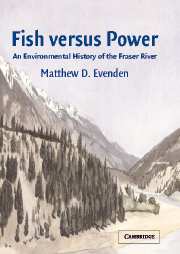Book contents
- Frontmatter
- Contents
- List of Tables, Figures, Photographs, and Maps
- List of Abbreviations
- Acknowledgments
- Introduction
- 1 “A Rock of Disappointment”
- 2 Damming the Tributaries
- 3 Remaking Hells Gate
- 4 Pent-Up Energy
- 5 The Power of Aluminum
- 6 Fish versus Power
- 7 The Politics of Science
- Conclusion
- Bibliography
- Index
2 - Damming the Tributaries
Published online by Cambridge University Press: 19 August 2009
- Frontmatter
- Contents
- List of Tables, Figures, Photographs, and Maps
- List of Abbreviations
- Acknowledgments
- Introduction
- 1 “A Rock of Disappointment”
- 2 Damming the Tributaries
- 3 Remaking Hells Gate
- 4 Pent-Up Energy
- 5 The Power of Aluminum
- 6 Fish versus Power
- 7 The Politics of Science
- Conclusion
- Bibliography
- Index
Summary
At Hells Gate, British Columbians had attempted to set the river free, but they had more experience in the opposite direction. Since the early days of the gold rush, starting in 1858 on the Fraser, the resettlement of BC had consequences not only for the land and for native space, but also for the rivers and lakes of the Western Cordillera. Small rivers had been diverted during the gold rush to supply placer mining outfits. Farmers had drawn from streams to water cattle and, increasingly, to supply irrigation districts in the semiarid regions of the interior. In the lower Fraser Basin, tributaries had been rerouted, diversion dams thrown up, and lakes drained to make way for more farmland. Burgeoning urban centers had reached into their hinterlands for domestic water supplies and repiped coastal rivers. All of these changes had shifted the social power over rivers and lakes from native to newcomer. From the vantage point of the twentieth century, they were just the beginning. With the expansion of the extractive resource economy and the rise of hydroelectricity after 1900, the rivers of BC came under increasing scrutiny as power sources and development sites. Diversion gave way to dreams of damming.
Before World War II, these dreams focused on tributaries and smaller systems. With the exception of one ill-fated proposal to dam the Fraser Canyon near Hells Gate in 1912, the idea of controlling the main stem of the Fraser was practically unimaginable.
- Type
- Chapter
- Information
- Fish versus PowerAn Environmental History of the Fraser River, pp. 53 - 83Publisher: Cambridge University PressPrint publication year: 2004



